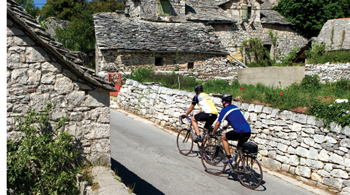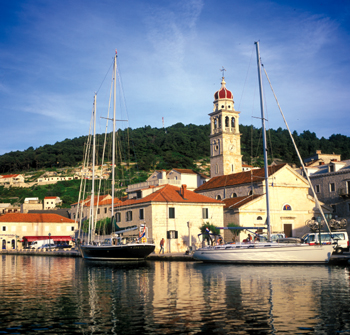Zagreb, Croatia’s capital city, has intrigued me for years. As I landed I felt the familiar tingle of excitement and trepidation that takes hold whenever I travel to a place for the first time. There was also the unsettling awareness of history—of Croatia’s terrible civil war in the early 1990s. But after more than a decade, I’d been told, reconstruction, healing and even a kind of serenity had prevailed. Croatia seemed ripe for a first-time visit.
Island Escape
Popular with northern Europeans, Croatia has just recently appeared on the radar of North American travelers. Having heard about this gateway to eastern Europe—specifically the famed beauty of the Dalmatian Coast and its brilliant Adriatic waters, rugged mountains and wondrous historic sites—I was eager to see it for myself. So when an opportunity arose to join a weeklong biking-and-boating excursion with a group of Marin friends, I jumped at it.
Meeting up in the Renaissance-era city of Dubrovnik, we took a quick shuttle to Gruz Harbor and boarded the Javorak, a classic wooden-hulled Adriatic cruiser that would be our private boat for the week. I found a spot to relax on top deck as we set sail for Mljet, the legendary isle where Homer’s Odysseus was captured by the sea nymph Calypso. Mljet was the first of four islands we would visit, each with a distinctively beautiful landscape to explore by bike. 
Three hours later we disembarked in the tiny fishing village of Prozurska Luka, off-loaded our bikes, donned biking gear and slathered on sunscreen for what promised to be an arduous day of cycling across the island, which is blanketed by dense forests and edged with limestone coves.
After a brief bike fitting and orientation, we set out at our own pace on the 18-mile route. Riding in small groups, we followed printed directions mounted on our handlebar bags, traveling Mljet’s narrow, lightly traveled roads through ruggedly stunning terrain. Pine- and oak-studded hills rose steeply above the sea, harboring ancient stone villages, vineyards and numerous garmas, or collapsed caves.
The hilly route to the seaside hamlet of Pomena took us through green and unspoiled Mljet National Park, whose primary attractions are two 10,000-year-old “lakes” (actually inlets) known for their unusually narrow passages out to the sea. An island in the middle of Veliko Jezero (“Big Lake”) was home to a 12th-century Benedictine monastery that once served as the cultural, religious and political center of Mljet. Our ride ended at the seaside Odisej Hotel, the park’s only accommodation. Later that evening we met for beers and a hearty dinner in the hotel’s taverna.
The next morning it was raining fairly hard during the two-hour boat transfer to Korcula (pronounced Kohr-choo-lah), an island lush with vineyards, olive groves and forests. Its centerpiece is the city of the same name, a walled medieval town reputed (but never verified) to be the birthplace of Marco Polo.
 Huddled around St. Mark’s Cathedral, the old quarter is known for its succession of skinny lanes that branch off like ribs from the “spine” of the main street—a clever layout apparently designed to protect the townfolk from the sun and wind. The Venetians came here in the 10th century and ruled on and off for more than 800 years, leaving a distinct mark on the town’s culture and architecture. Today, Korcula is a trove of Gothic and Renaissance palaces, courtyards, churches and graceful arched bridges. The town’s thick walls and imposing towers, once a defense against marauding pirates, date back to the 14th century.
Huddled around St. Mark’s Cathedral, the old quarter is known for its succession of skinny lanes that branch off like ribs from the “spine” of the main street—a clever layout apparently designed to protect the townfolk from the sun and wind. The Venetians came here in the 10th century and ruled on and off for more than 800 years, leaving a distinct mark on the town’s culture and architecture. Today, Korcula is a trove of Gothic and Renaissance palaces, courtyards, churches and graceful arched bridges. The town’s thick walls and imposing towers, once a defense against marauding pirates, date back to the 14th century.
Image 1: Cruising the Dalmatian Coast on the Javorak, our island-hopping vessel.
Image 2: Biking through an ancient stone village on Brac.
The skies cleared after our walk through town and we started out on a 23-mile pedal to Brna, riding past tidy rows of grapevines and groves of almond trees. We stopped along the way in Smokvica for a tour of the family-owned Toreta Winery and tasting of some excellent regional sweet white wines before arriving at the waterfront Hotel Feral.
The next day’s ride, only 15 miles, started in the seaside town of Vela Luka, at the western end of the island. An easy spin along the coast got us warmed up for a heart-pumping, three-mile climb before a drop back into Vela Luka port.
From there we took a three-hour cruise to the island of Hvar, a chic destination on the southern end of the Dalmatian archipelago marked by ragged inlets, a steep central limestone ridge and translucent waters. In the town of Hvar, we saw Croatia’s most impressive collection of Venetian Renaissance facades, public squares and bougainvillea-draped homes. Our hotel, the Podstine, was a half mile west of the town center, overlooking a beautiful bay.
A leisurely bike exploration of Hvar Island began with a ride overlooking the town. An ascent along the Sveti Nikola (the limestone ridge) provided plunging views in both directions. En route we cycled by ancient stone terraces topped by tiny plots of lavender, grape vines and fig trees. A long downhill leg and a stretch of mostly flat riding—the gentlest route of the week so far—brought us on narrow, lightly trafficked roads to pleasant Stari Grad and sleepy old Faros, a town with a picturesque promenade and outdoor cafes.
Back in Hvar Town, we spent the late afternoon enjoying beers and people-watching in the marble-paved main square, the largest in Dalmatia. Nearby are a 17th-century Venetian arsenal, which now holds a theater, and a 15th-century Franciscan monastery with gardens overlooking the sea. This seemed like Dalmatian living at its very best.
THE BEACHES OF BRAC
 We shuttled east to the town of Jelsa, returned to our bikes and rode along the spine of the island, passing through a series of tiny villages, climbing to Gdinj and ending in Sucaraj in the early afternoon. Reboarding our boat, we headed for Brac, the final island of our trip. The four-hour sail was a perfect time to catch up on reading.
We shuttled east to the town of Jelsa, returned to our bikes and rode along the spine of the island, passing through a series of tiny villages, climbing to Gdinj and ending in Sucaraj in the early afternoon. Reboarding our boat, we headed for Brac, the final island of our trip. The four-hour sail was a perfect time to catch up on reading.
Brac, pronounced “bratch,” means “the Big One,” and this is indeed Dalmatia’s largest as well as most Mediterranean island, famed for its cheeses and resplendent with cypress, orange and olive trees. Since ancient Greek times, Brac has also been renowned for its milky-white marble (some of which was used to build the White House in Washington). Our hotel for the next two nights, the Palaca Deskovic, is a recently refurbished cultural monument, on one of the many bays of the island’s north coast.
The final big ride of the week was a challenging 28-miler. It started with a long climb up and over Brac’s ridgeline followed by a dramatic drop into Bol, a delightful seaside community with old stone houses and a lively promenade. Nestled on the far side of Vidova Gora, the highest mountain on the Croatian islands, it was a scenic spot for lunch on the town’s boardwalk. Bol is best known for its pebble beach, Zlatni Rat (Golden Cape), which spans the wooded shoreline just west of the island’s midpoint, extending like a narrow finger into the sea and a fitting place to celebrate our truly enjoyable journey along the serene and sunny Croatian coast.
Image 3: Late afternoon brightens the marble facades of Pucisca, a harbor town on the island of Brac.


